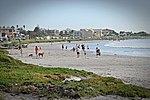Battle of Blaauwberg
1806 in the Cape ColonyBattles involving the Batavian RepublicBattles involving the United KingdomBattles of the War of the Third CoalitionConflicts in 1806 ... and 3 more
January 1806 eventsMilitary history of the Cape ColonyUse South African English from April 2012

The Battle of Blaauwberg, also known as the Battle of Cape Town, fought near Cape Town on Wednesday 8 January 1806, was a small but significant military engagement during the Napoleonic Wars. After a British victory, peace was made under the Treaty Tree in Woodstock. It established British rule over the Dutch Cape Colony, which was to have many ramifications for the region during the nineteenth and twentieth centuries. A bi-centennial commemoration was held in January 2006.
Excerpt from the Wikipedia article Battle of Blaauwberg (License: CC BY-SA 3.0, Authors, Images).Battle of Blaauwberg
Military Road,
Geographical coordinates (GPS) Address Nearby Places Show on map
Geographical coordinates (GPS)
| Latitude | Longitude |
|---|---|
| N -33.756111111111 ° | E 18.465555555556 ° |
Address
Military Road
Military Road
, Cape Town Ward 23
Western Cape, South Africa
Open on Google Maps






